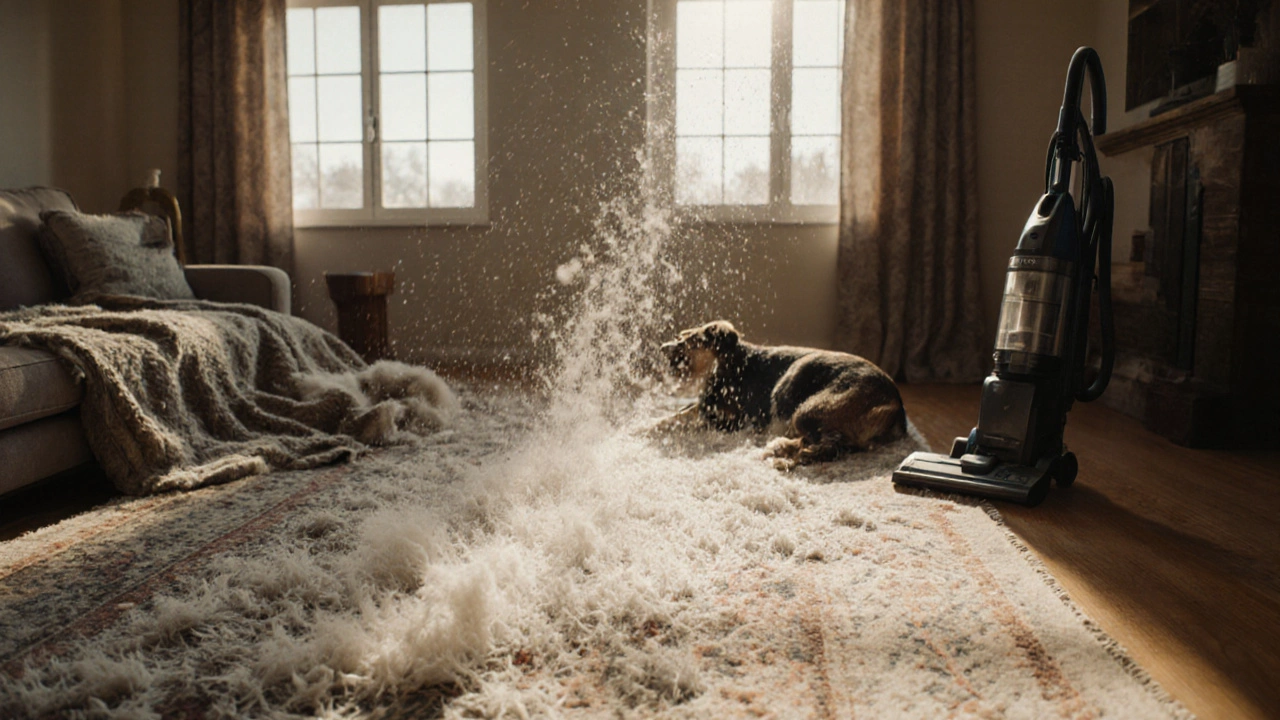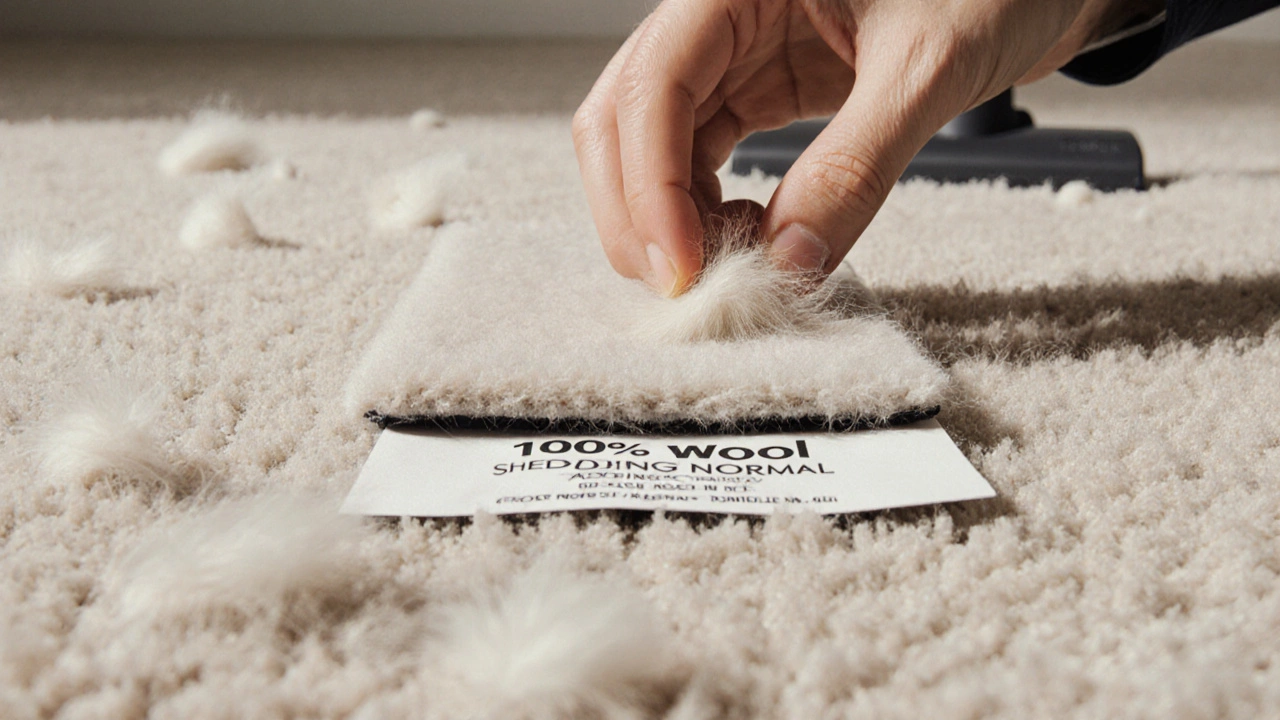Which Rugs Shed the Most? Top 5 Shedding Rugs and How to Avoid Them

Rug Shedding Severity Checker
How much will your rug shed?
Select your rug characteristics to estimate shedding severity. Based on data from the Rug Institute and real customer reviews.
Everyone loves a soft, cozy rug underfoot-until you start finding fuzzy clumps on your socks, your dog’s bed, and your kitchen counters. If you’ve ever vacuumed the same spot three times a day just to keep up, you’re not alone. Some rugs shed like crazy, and not all of them are cheap or low quality. In fact, the most luxurious rugs often shed the most. The truth? Shedding isn’t always a defect-it’s a feature of how the rug was made.
Why Do Rugs Shed in the First Place?
Shedding happens when loose fibers from the rug’s surface come loose during normal use. It’s most common in hand-woven, hand-tufted, or cut-pile rugs. Think of it like new jeans fading or a sweater pilling-some materials just need time to settle. A little shedding in the first few weeks is normal. But if you’re still finding piles of fuzz after three months, you’ve got a problem.
The culprit is usually the fiber type, how the yarn was spun, and how the pile was cut. Natural fibers like wool, cotton, and silk tend to shed more than synthetics like polyester or nylon. But that doesn’t mean synthetics are better-they just shed differently. Wool sheds loose fibers; polyester sheds tiny plastic bits that cling to everything.
The Top 5 Rugs That Shed the Most
Not all rugs are created equal. Here are the five types you should avoid if you hate cleaning up fuzz.
- Hand-knotted wool rugs - These are the most expensive and beautiful rugs on the market, but they’re also the heaviest shedders. Wool fibers are naturally springy and loosely anchored in the backing. High-pile Persian or Turkish rugs can shed for 6-12 months. One study from the Rug Institute found that 78% of hand-knotted wool rugs showed visible shedding after 90 days of daily use.
- Sheepskin and hide rugs - These look luxurious and feel amazing, but the short hairs on the hide loosen over time. You’ll find them on your couch, in your coffee cup, and stuck to your black pants. They shed more than you’d expect, especially in dry climates or with central heating.
- Chenille rugs - Made from twisted yarns that form a velvety pile, chenille rugs look plush but are basically fiber bombs. The loops are loosely woven and easily pulled apart. Even light foot traffic can cause noticeable shedding. Many buyers regret these after the first vacuum.
- Shag rugs with natural fibers - Long, fluffy shags made from cotton, jute, or wool are a design trend that doesn’t last. The longer the pile, the more surface area for fibers to break free. Shag rugs made with wool or cotton can shed for over a year. If you have pets or kids, this is a recipe for daily cleanup.
- Hand-tufted wool rugs - These are cheaper than hand-knotted ones but still made with wool. The backing is glued, not woven, so fibers don’t hold as tightly. They shed less than hand-knotted rugs but still more than most synthetics. Many retailers market them as “low-shed,” but that’s misleading.
Which Rugs Shed the Least?
If you want to skip the vacuuming marathon, choose rugs made with tightly woven synthetics or low-pile designs.
- Machine-woven polyester rugs - These are the top pick for low shedding. The fibers are bonded under heat and pressure, making them nearly impossible to pull loose. Brands like Safavieh and Ruggable use this tech in their best-selling lines.
- Nylon rugs - More durable than polyester and still low-shedding. Nylon holds up better under heavy foot traffic and doesn’t attract static, which reduces fiber clinging.
- Flatweave rugs - Kilim, dhurrie, and braided rugs have no pile at all. That means no loose fibers to shed. They’re easy to clean, lightweight, and work great in high-traffic areas like hallways or entryways.
- Outdoor rugs (indoor use) - Made from polypropylene, these are designed to handle rain, sun, and dirt. They shed almost nothing and are perfect for homes with pets or kids. Many look like indoor rugs-just don’t buy the ones with faux wool textures.

How to Tell If a Rug Will Shed Before You Buy It
You shouldn’t have to guess. Here’s how to spot a high-shedding rug before it’s too late.
- Check the fiber content - Look for labels that say “100% wool,” “natural fibers,” or “hand-tufted.” These are red flags. Instead, look for “100% polyester,” “polypropylene,” or “machine-woven.”
- Run your hand over the surface - If you feel loose fibers or see fuzz sticking to your palm, it’s going to shed. A tightly woven rug should feel smooth, not fuzzy.
- Ask about the pile height - The taller the pile, the more it sheds. Avoid anything over 0.75 inches unless you’re okay with daily cleaning.
- Read the reviews - Look for comments like “shedding like crazy,” “still vacuuming after 6 months,” or “my dog looks like a woolly mammoth.” Skip rugs with more than 10% of reviews mentioning shedding.
- Check the backing - Glued-backing rugs (like hand-tufted ones) shed more than woven-backing rugs. Look for “jute backing” or “woven cotton backing” for better durability.
How to Reduce Shedding (Even If You Already Bought a Shedy Rug)
Don’t toss it yet. You can cut shedding by up to 70% with simple habits.
- Use a vacuum with a beater bar - Don’t use a suction-only vacuum. A beater bar helps lift fibers before they break free. Vacuum once a week for the first month, then twice a month after that.
- Rotate your rug every 3 months - This evens out wear and prevents one area from getting overly stressed. It also helps fibers settle more evenly.
- Use a rug pad - A rubber or felt pad reduces friction between the rug and floor. Less movement = fewer broken fibers.
- Wash it (if possible) - Some synthetic rugs are machine-washable. Washing removes loose fibers and resets the pile. Always check the label first.
- Don’t use a broom - Brooms tug at fibers and make shedding worse. Stick to vacuuming.

When Shedding Is a Sign of a Bad Rug
Shedding for the first 30-60 days? Normal. Shedding after 90 days? Red flag. If your rug is still losing clumps after three months, it’s likely made with low-grade materials or poor construction. Cheap wool rugs, for example, are often made from recycled fibers that break apart easily. If you bought a $200 rug labeled “Persian-style” and it’s shedding like a dog in spring, you got scammed.
Real hand-knotted Persian rugs can shed for up to a year-but they’re $2,000+, not $200. If the price seems too good to be true and it’s shedding like crazy, it’s probably synthetic wool blend with a fake label.
Final Tip: Match the Rug to Your Lifestyle
Don’t buy a shaggy wool rug for a home with three dogs and a toddler. Don’t buy a flatweave for a bedroom where you want to sink your toes. Think about your daily life: Do you walk barefoot? Do you have pets? Do you clean often? Choose a rug that fits your routine, not your Pinterest board.
Low-shedding rugs aren’t boring. Modern machine-woven rugs come in bold patterns, rich colors, and textures that mimic wool without the mess. You can have beauty without the cleanup. It’s not about sacrificing style-it’s about choosing smart.
Do all wool rugs shed?
Yes, all wool rugs shed to some degree, especially when new. Hand-knotted wool rugs shed the most because the fibers are individually tied into the backing, leaving loose ends. Even high-quality wool rugs can shed for 6-12 months. Machine-woven wool rugs shed less but still more than synthetic options.
Can you stop a rug from shedding completely?
You can’t stop shedding entirely if the rug is made with natural fibers like wool or cotton. But you can reduce it significantly by using a good vacuum, adding a rug pad, rotating the rug regularly, and avoiding rough cleaning tools like brooms. Synthetic rugs like polyester and polypropylene shed so little that you won’t notice after the first few weeks.
Is shedding a sign of poor quality?
Not always. High-end hand-knotted wool rugs are supposed to shed at first-it’s part of the natural process. But if a cheap rug (under $300) is still shedding badly after 90 days, it’s likely made with recycled or low-grade fibers. Quality matters: a $1,000 wool rug will shed less over time than a $150 one.
What’s the best rug for pet owners?
Machine-woven polyester or polypropylene rugs are the best for pet owners. They don’t trap fur, shed almost nothing, and are easy to clean. Look for low-pile, stain-resistant options. Avoid shags, chenille, and wool rugs-they collect pet hair, shed fibers, and are hard to deep clean.
How long does rug shedding last?
For synthetic rugs, shedding usually stops after 2-4 weeks. For wool rugs, it can last 3-12 months. The first 30 days are the worst. After that, shedding drops off sharply. If it’s still shedding heavily after 6 months, the rug is poorly made or the fibers are damaged.